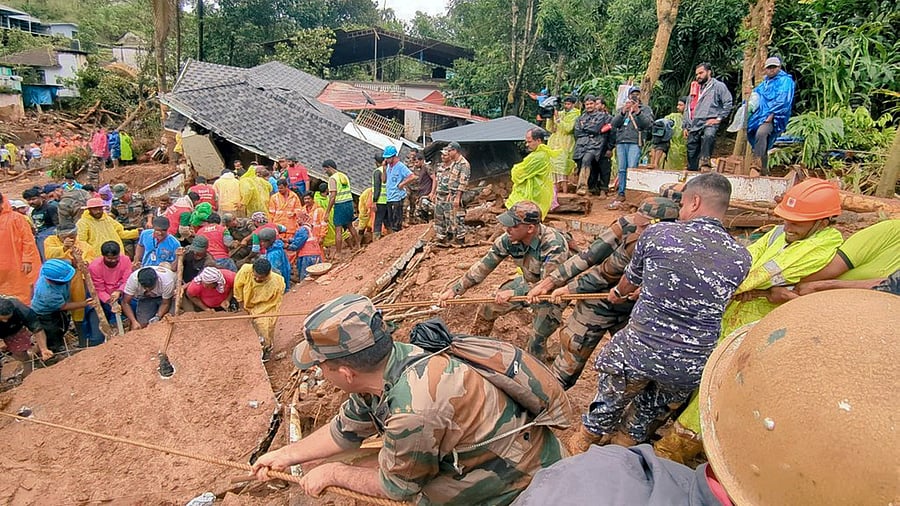
Rescue operations after landslides triggered by heavy monsoon rains, in Wayanad dristrict.
Credit: PTI Photo
The landslides and flash floods that swept through Wayanad in Kerala have devastated a part of the district, causing unprecedented death and destruction.
Over 250 people are reported dead and many more are missing. Entire villages, houses, schools, buildings, roads and bridges have been obliterated.
Many structures and natural formations have disappeared. But the tragedy at Wayanad is bigger than the sum total of the dead and missing people and the devastation.
It was a tsunami in the hills which, in a few hours, turned a tourist paradise into a graveyard. It is also a grim warning that the mistakes of the past are catching up with the present and threatening the future.
The immediate task is to implement rescue, relief, and rehabilitation efficiently and limit the damage.
It is a human tragedy causing great pain and trauma, individual and collective, and the full extent of the loss and damage is still unknown.
Many agencies, including the armed forces, the National Disaster Response Force (NDRF), the fire services, and the police are involved in the operations, and they have done good work locating trapped people, shifting the injured to hospital, and taking people to relief camps.
The work will continue for days, and rehabilitation of the displaced people will take longer. Rebuilding places washed away by the disaster is a mammoth task as there is no trace of what stood there before.
Many people have lost their families and belongings. It is necessary to aid and support them, and at the same time learn lessons from this and other disasters.
Kerala experienced a great deluge in 2018, and has witnessed many landslides, flash floods, and extreme weather events in the last few years. The same region has seen landslides in the past. Many warnings have been issued about the impact of the unrelenting attacks on nature, but they have gone unheeded.
In 2011, the Gadgil Commission comprehensively documented the threats to the Western Ghats ecology caused by human actions, including deforestation, encroachment, construction and mining.
The report predicted disasters such as the present one, and suggested steps to avoid them.
The government appointed the Kasturirangan committee to dilute the Gadgil report recommendations. Even the diluted recommendations were not implemented.
Under political and other kinds of pressure, the recommendations were ignored. What we see now in the Western Ghats region is a pincer attack by climate change and degraded ecology, the two aggravating each other. Wayanad should serve as a warning not just to Kerala but to other states as well.
